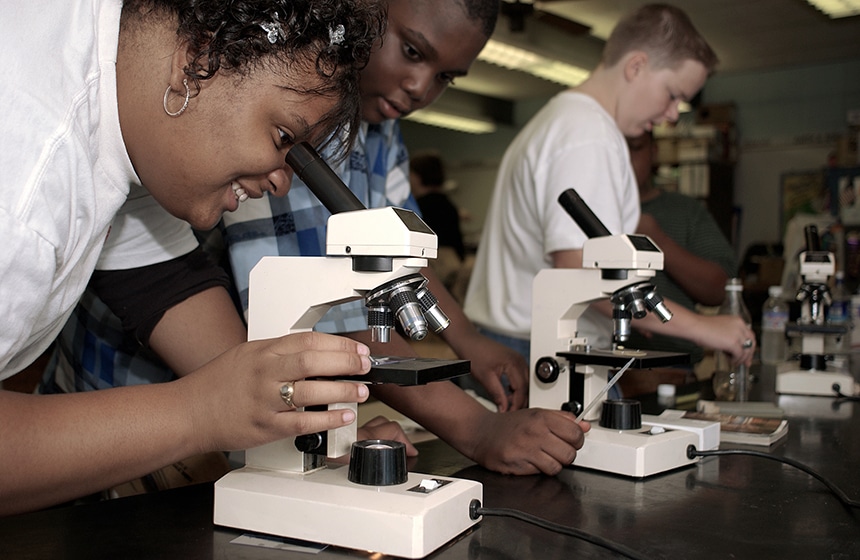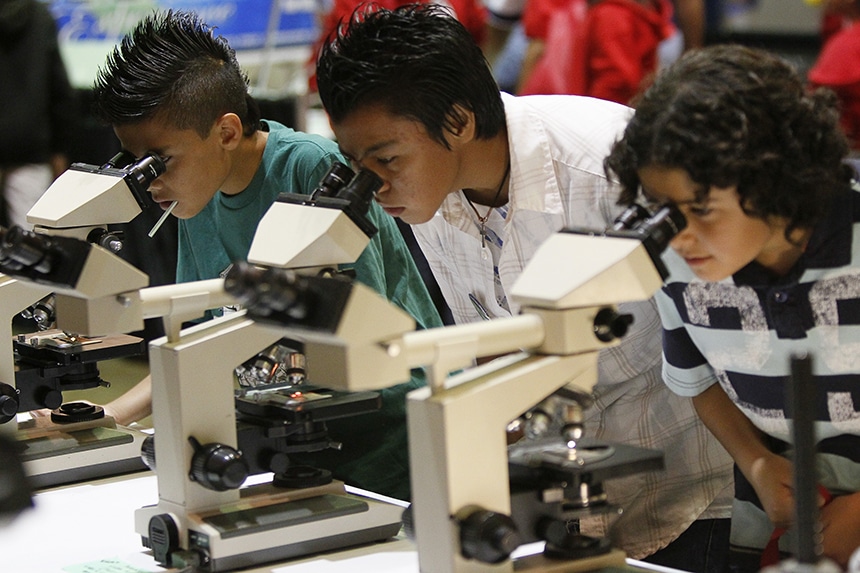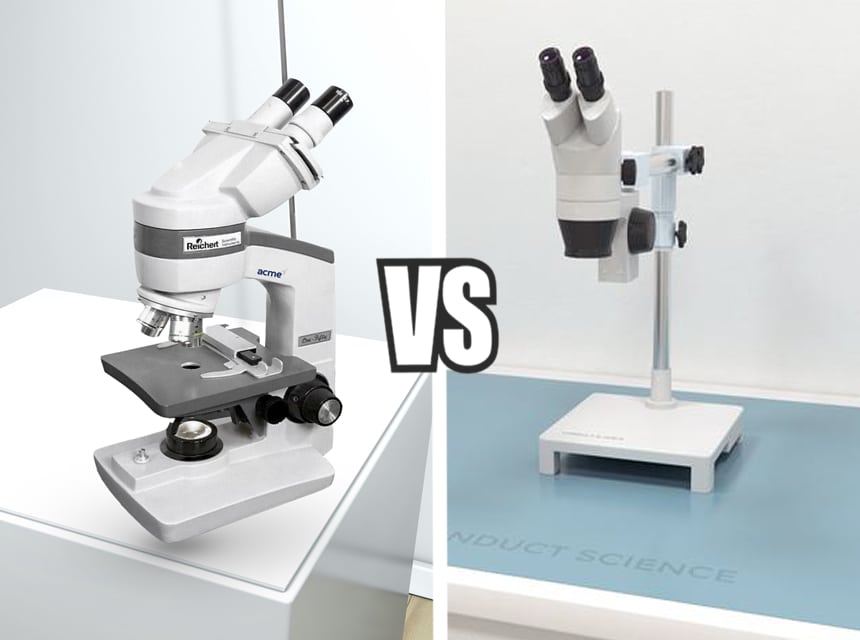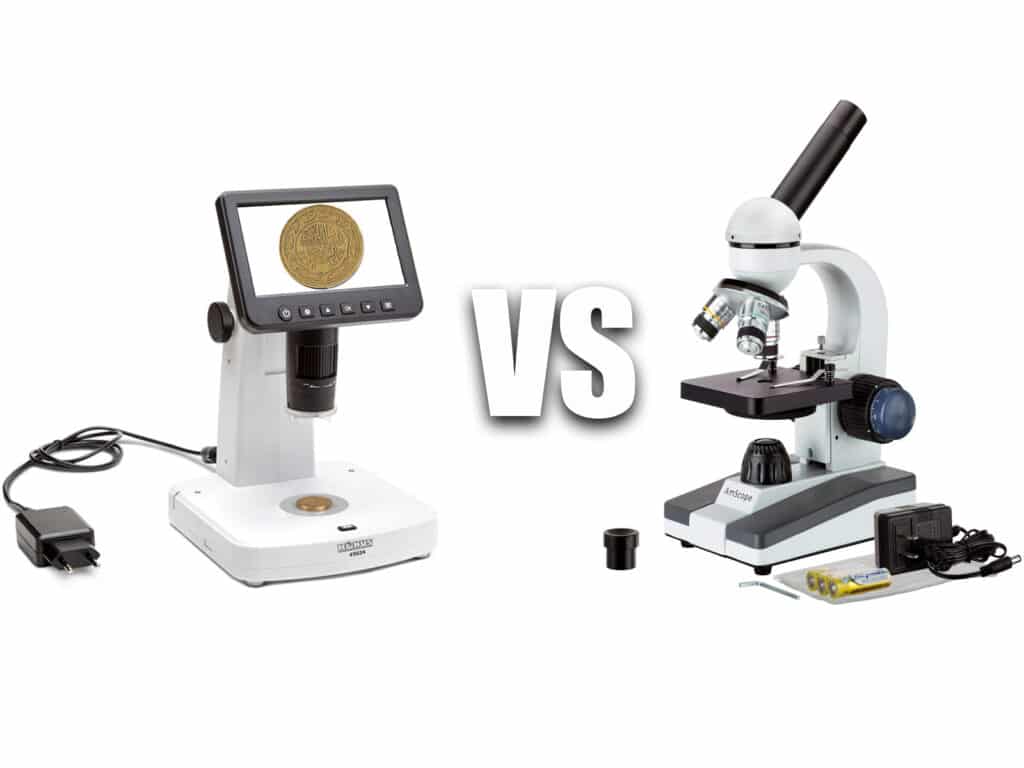

With their grades and general science knowledge on the line, buying microscopes for students is not a process that should be taken lightly. A slight misstep could lead to further confusion and miseducation while trying to impart knowledge on the kids. If you want the best microscopes for students to use, you can get them by reviewing all options you come across.
Reviewing potential purchases requires that you look into the type. With this, you get to find out how the microscope works. Finding out about magnification levels is another part of your review process. Of course, you should know how much magnification students can get out of the product and if it is enough for the subject or specimens they observe. How subjects are illuminated seems essential as well since subjects need to be well lit. Finally, confirming that the optics are good enough for the job at hand and that the construction is solid will get you closer to getting the best microscopes for students in the market. If you want this whole process to be easier, you should keep reading, and you will find some options that fit the criteria.
Other features: quadruple nose-piece, built-in mechanical stage
Our first microscope option is the Meiji Techno MT-14 Compound Rechargeable Microscope. Since this is a compound microscope, it will allow your students to see micro-specimens that would typically be invisible without the gadget’s help.
As you can see, magnification levels are 40x, 100x, 400x, and 1000x. Four objective lenses allow for these levels of magnification. These lenses are attached to the nose-piece for easy rotation.
LED illumination is also a nice feature to have. Notably, the light’s intensity is adjustable, and thus, students can cope with various samples and lighting conditions with relative ease.
Also, the rechargeable battery can come in handy for fieldwork. This battery is also likely to last a full day since the microscope features low power consumption.
Additionally, the built-in mechanical stage is there for the student’s convenience. With this, the kids won’t have difficulty adjusting the slides to view the specimens better.
Due to its build, this microscope is relatively hard to damage and easy to store. Remember that a dust cover is also included in the package, and for your optical components to remain pristine, you should use it.
This option incorporates two eyepieces in the design. Also, for enhanced comfort, the eyepieces are fitted with rubber eye guards. This, in turn, may allow students to use the microscope for longer.
What we liked: we liked the rubber eye guards provided. Also, the dust cover may come in handy when the product is in storage. The adjustable LED lighting will help in a variety of specimen viewing conditions. The four levels of magnification are also impressive. Finally, the rechargeable battery does allow students to use the microscope outside of a conventional science lab or classroom.
What could be better: The microscope could be a little more affordable. No slides are provided, so you will have to buy some, increasing the price of ownership.
Other features: binocular head, 10x WF eyepieces, coaxial focusing, mechanical stage, iris diaphragm, inter-pupillary distance adjustment
Parallels between the Meiji Techno MT-14 Compound Rechargeable Microscope and the UNICO M250LED Student Microscope are quite numerous. The fact that they are both compound microscopes is one of them. Also, if you haven’t noticed, the magnification levels are similar as well, with the options being 40x,100x,400x,1000x in that order.
As you would expect, a four-position nose-piece allows you to toggle and switch between the magnification levels available. Another similarity is the LED illumination.
The microscope comes with a 3W LED Bulb that can be powered by a battery. As a result of battery-powered illumination, the UNICO M250LED Student Microscope is just as portable as the editor’s choice. Notably, an AC adapter is added to the purchase, making it possible to use while plugged into a power source.
Each of the eyepieces in the binocular head features 10x magnification. Also, students get interpupillary distance adjustment alongside diopter control on one of the eye tubes in the binocular head. With this, differences between the eyes of students won’t be a problem.
An easy to use mechanical stage is also part of the charm of this microscope. Notably, the quality of the optical components of this purchase is top-notch. This is because color correction and hardening agents are added. Also, the surfaces of the optical elements are coated with anti-fungal agents in addition to being sealed and polished.
What we liked: We liked the binocular design that caters to the needs of all students by including a diopter as well as interpupillary distance adjustment. The optical elements in the microscope also seem a notch above the rest. Additionally, this option is portable as a result of being battery powered. The option to plug it into a socket is also there. The magnification levels provided are also impressive.
What could be better: This is another pricey microscope. The LED lighting does not provide as much light as halogen options.
Other features: lifetime warranty, glass optics, WF16x eyepiece, video recording, 360° rotatable head
Next is the Levenhuk Rainbow D50L PLUS 2M Digital Microscope, which makes an excellent case as to why it should be listed. Kids will especially enjoy using this option because of the built-in camera. Consequently, it has image and video recording capabilities that can be useful if you want to publish your experiments on social media.
The product has three objective lenses that feature 64x, 160x, and 640x in terms of magnification. As the user, you can also choose to engage the Barlow lens, which doubles the objective lenses’ magnification. As such, the final magnification range is between 64x and 1280x.
Another perk of using this microscope is to observe specimens on a PC screen instead of the eyepiece. This requires connecting the microscope and your PC via the USB cable. However, you can still use the eyepiece if you want to.
Additionally, buyers get the software to install on their computers that helps take pictures and video. Another thing that sets this microscope apart is the two LED illumination options. Both the upper and lower LED lights offer adjustable intensity.
Also, you don’t have to turn on both lights at the same time. However, individual specimens will require more lighting than others. As for power, you have three options: one is the USB option that powers the camera. For the rest of the microscope, you will either have to plug it in or use AA batteries.
An experiment kit is also provided to help students on their science discovery journey. The most prominent parts of this kit are the prepared slides and the tools to create some new slides. Finally, a protective plastic case will keep students at ease while they transport this product.
What we liked: We liked that this microscope comes with an experiment kit as well as a protective case. Students can use either AA batteries or plug the microscope into a source of power. The dual LED lighting is useful and practical. Additionally, observation of specimens on a PC screen is possible. The camera and lifetime warranty are the icing on the cake.
What could be better: A rechargeable battery like the one in the Meiji Techno MT-14 Compound Rechargeable Microscope would be cheaper for fieldwork.
Other features: supplied with two 10x WF eyepieces and four achromatic objectives, double-focusing regulation, 360° revolving binocular head
The Konus Campus 1000x Biological Microscope is also worth a feature on this list. It ships with a 360° revolving binocular head, which incorporates two 10x WF eyepieces. The highest magnification on this device is 1000x.
Once you have put the slide on the stage, you can make micrometric movements to position it well under the objective lens. Since you are looking through the eyepiece, it is very easy to overdo the adjustments and end up crashing the slide. However, and end-stop has been included to safeguard your slides.
Unlike the two microscopes mentioned above, this option uses halogen lighting. Nonetheless, you still get light regulation capabilities with this option.
Buyers should know this microscope needs to be plugged in for it to work. Remember that different continents use varying socket systems, and you need to account for that as you make the purchase. If you purchase the European socket option as an American, you may have a more challenging time using it.
Another benefit for students is the inter-pupillary distance regulation. Since the inter-pupillary distance varies from person to person, this feature helps cater to different students’ needs. Finally, an anti-dust cover is also provided for users.
What we liked: This microscope for kids comes with an anti-dust cover. The inter-pupillary distance adjustment helps cater to different student’s needs. Adjustable light intensity is another benefit. Finally, the end-stop to protect your slides is a handy addition.
What could be better: Customer service doesn’t seem impressive. Also, setup and use instructions could be clearer to help newbies use the device.
Other features: two individual 10x eyepieces, large focusing knobs
An excellent microscope for elementary kids is the Barska AY13116 Student Stereo Microscope. Seeing as though this is a stereo microscope, magnification is less than you would find in most compound options. Consequently, the only magnification options you have with this purchase are 20x and 50x.
This device’s objective lens features 2x magnification while the two eyepieces provided offer 10x and 25x magnification. Some product highlights include large focusing knobs that make getting clear images out of your samples a piece of cake.
Another highlight is the LED specimen illumination. Additionally, you should note that various slides are provided with the purchase. Five of these slides have already been prepared, while seven others are blank.
What we liked: The simple design of the microscope makes it easy to use for younger kids. The provided slides also mean you may not have to deal with some extra expenses. Finally, this microscope is relatively affordable.
What could be better: Due to the magnification range, this microscope does not allow the observation of tiny specimens the size of bacteria. As such, the level of use is quite limited.
Other features: monocular head, large table base
The merits of the Discovery Kids 44-50450 Student Microscope also ensured it has a place on today’s list. It is another compound microscope with a maximum magnification of 450x.
Notably, a monocular head is provided, so you can only use one of your eyes for observation. If you cannot clearly see the specimens, all you need to do is turn the LED lighting.
Also notable in this microscope for kids is the large table base, which affords stability during experiments. Additionally, prepared and blank slides are part of the package. This is in addition to a drawstring carry case for when the microscope needs to be moved or stored.
What we liked: We liked the simple microscope design, which is perfect for kids to use. Also, the slides provided can help introduce kids to micro-specimens. Finally, the carry case is an asset.
What could be better: There are no current downsides to report with regard to this microscope.
All the information our team has provided above may lead to further confusion for some of you, making it more challenging to get the purchase right. However, an effective way of reducing the confusion is reading the buying guide below. It tells you what to prioritize in terms of features and design decisions and how these factors will affect use.

How high the microscope ranks on our list is entirely dependent on features. These can make or break a student’s experience, and thus, you need to be careful when selecting which features are essential in the microscope you purchase. The information below explaining all microscope features may provide some clarity on the same.
Most buyers pick between compound and stereo microscopes. However, their uses are different. Stereo microscopes, also known as low power microscopes, are better for viewing larger items. This can be anything from insects, soil, or even fabric weaves.
Compound microscopes often offer more magnification power and are preferred by a lot of people. They are perfect for biology since they can help students view bacteria, blood cells, insect legs, and numerous microorganisms.
Once you’ve decided on the specimens’ types to view, you can then pick one of these two options.
A digital microscope is also an option. The optics of a digital microscope can be paired with a camera. This allows the specimen to be viewed via a monitor rather than through the eyepiece. The Levenhuk Rainbow D50L PLUS 2M Digital Microscope is a perfect example.
Optics will also determine the quality of the image derived from the specimen. One of the reasons why the UNICO M250LED Student Microscope is among our top three picks is the optics. The optical elements are designed to ensure excellent color. They also don’t damage easily, and even the anti-fungal treatment helps keep away elements that might interfere with the image.
Aside from the optics, the rest of the microscope also needs to be top-notch. This starts with the construction. Remember that handling may be difficult if the students are afraid of breaking the microscopes. As such, picking durable options sets them at ease and allows them to learn.
Illumination is another box to check as you shop for the ideal microscope. Previously, manufacturers used mirrors to reflect light and illuminate the specimens. However, this light has been known to be unreliable. Consequently, you will find the most modern options have inbuilt light sources. This is why they need a power source such as a battery or an AC power connection.
LED and halogen are your main lighting options. LED is more popular and should be since it is more durable and consumes less power. As such, options like the Discovery Kids 44-50450 Student Microscope are very competitive in the market. Halogen lighting, on the other hand, is brighter.
Also, look out for adjustable lighting as it can be immensely beneficial. Remember, ambient light will vary according to seasons and according to the time of day. Additionally, different specimens require varying levels of light for optimum visibility.
Fluorescent and tungsten illuminated microscopes are not as common as LED and halogen options.
Another area of concern is the Iris diaphragm and Abbe condenser. These two are also there for the control of light and are often situated under the stage. The iris diaphragm helps students control the amount of light reaching a specimen while its counterpart, the Abbe condenser, helps focus the light. If you feel the extra light control is essential for your students, ensure these elements are included in the purchase.
A mechanical stage should help you position your slides optimally so you can view your specimens with relative ease. The Konus Campus 1000x Biological Microscope has an impressive stage that even allows users to make micrometric adjustments as one of its perks. As such, ensure the mechanical stage that you get with your microscope is beneficial as well.
As for the Meiji Techno MT-14 Compound Rechargeable Microscope, it uses a rechargeable battery for most of its power needs. As such, students can plug it in a few hours before they head out for fieldwork and will still be able to use the microscope even with no sockets in sight.
Even the Levenhuk Rainbow D50L PLUS 2M Digital Microscope has something similar where you can buy AA batteries for use in the field. While you are in a traditional lab setting, you can use an AC socket to power the kids’ microscope.
If you don’t have plans of letting your students out of the lab or classroom situation with the microscope, you can still make do with options that require a socket. The power source you pick will depend on the intended use.

Microscopes that can be taken to the field also need to be lightweight and compact. That way, they won’t be as tiring to carry in a bag. If, conversely, the microscopes are stored and used in the same place, it may not be necessary to purchase a small and compact model.
Two extra features can be seen in the Levenhuk Rainbow D50L PLUS 2M Digital Microscope. One is the camera support that would allow users to record images and videos of their experiments. They can as well show off their work on social media. Another extra feature is the 360° rotatable head, which would allow different students to look through the eyepiece without moving the entire device. These extra features are valuable and may lead to increased pricing of the microscope. However, for most people, these additional features are worth it.
If you are still unsure, we have our top three recommendations, including the Meiji Techno MT-14 Compound Rechargeable Microscope, the UNICO M250LED Student Microscope, and the Levenhuk Rainbow D50L PLUS 2M Digital Microscope.
The Meiji Techno MT-14 is an excellent option for fieldwork and classwork as well. The inclusion of rubber eye guards is a significant positive since you don’t want your students uncomfortable. Magnification levels are also top-notch.
Differences between the Meiji Techno MT-14 and the UNICO M250LED are minimal. Nevertheless, with the latter, you even get inter-pupillary distance adjustment and diopter control. This should allow all students to see through the binocular eyepieces clearly.
If you want your students to share their achievements, you can pick the Levenhuk Rainbow D50L PLUS 2M Digital Microscope. This is because it incorporates a camera and has video and image recording capabilities.
If you’ve used other microscopes for students that you feel should feature on this list, inform us and we will look into them. For the rest of you, make use of this write-up to ensure your microscope purchase is one you will be proud of.





